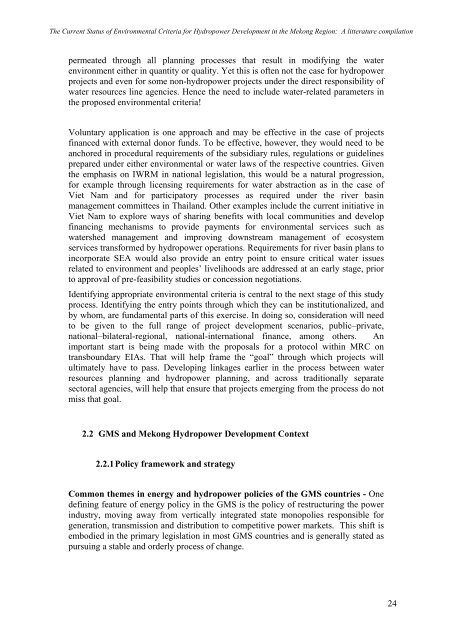Environmental Criteria for Hydropower in the Mekong Region - WWF
Environmental Criteria for Hydropower in the Mekong Region - WWF
Environmental Criteria for Hydropower in the Mekong Region - WWF
Create successful ePaper yourself
Turn your PDF publications into a flip-book with our unique Google optimized e-Paper software.
The Current Status of <strong>Environmental</strong> <strong>Criteria</strong> <strong>for</strong> <strong>Hydropower</strong> Development <strong>in</strong> <strong>the</strong> <strong>Mekong</strong> <strong>Region</strong>: A litterature compilation<br />
permeated through all plann<strong>in</strong>g processes that result <strong>in</strong> modify<strong>in</strong>g <strong>the</strong> water<br />
environment ei<strong>the</strong>r <strong>in</strong> quantity or quality. Yet this is often not <strong>the</strong> case <strong>for</strong> hydropower<br />
projects and even <strong>for</strong> some non-hydropower projects under <strong>the</strong> direct responsibility of<br />
water resources l<strong>in</strong>e agencies. Hence <strong>the</strong> need to <strong>in</strong>clude water-related parameters <strong>in</strong><br />
<strong>the</strong> proposed environmental criteria!<br />
Voluntary application is one approach and may be effective <strong>in</strong> <strong>the</strong> case of projects<br />
f<strong>in</strong>anced with external donor funds. To be effective, however, <strong>the</strong>y would need to be<br />
anchored <strong>in</strong> procedural requirements of <strong>the</strong> subsidiary rules, regulations or guidel<strong>in</strong>es<br />
prepared under ei<strong>the</strong>r environmental or water laws of <strong>the</strong> respective countries. Given<br />
<strong>the</strong> emphasis on IWRM <strong>in</strong> national legislation, this would be a natural progression,<br />
<strong>for</strong> example through licens<strong>in</strong>g requirements <strong>for</strong> water abstraction as <strong>in</strong> <strong>the</strong> case of<br />
Viet Nam and <strong>for</strong> participatory processes as required under <strong>the</strong> river bas<strong>in</strong><br />
management committees <strong>in</strong> Thailand. O<strong>the</strong>r examples <strong>in</strong>clude <strong>the</strong> current <strong>in</strong>itiative <strong>in</strong><br />
Viet Nam to explore ways of shar<strong>in</strong>g benefits with local communities and develop<br />
f<strong>in</strong>anc<strong>in</strong>g mechanisms to provide payments <strong>for</strong> environmental services such as<br />
watershed management and improv<strong>in</strong>g downstream management of ecosystem<br />
services trans<strong>for</strong>med by hydropower operations. Requirements <strong>for</strong> river bas<strong>in</strong> plans to<br />
<strong>in</strong>corporate SEA would also provide an entry po<strong>in</strong>t to ensure critical water issues<br />
related to environment and peoples’ livelihoods are addressed at an early stage, prior<br />
to approval of pre-feasibility studies or concession negotiations.<br />
Identify<strong>in</strong>g appropriate environmental criteria is central to <strong>the</strong> next stage of this study<br />
process. Identify<strong>in</strong>g <strong>the</strong> entry po<strong>in</strong>ts through which <strong>the</strong>y can be <strong>in</strong>stitutionalized, and<br />
by whom, are fundamental parts of this exercise. In do<strong>in</strong>g so, consideration will need<br />
to be given to <strong>the</strong> full range of project development scenarios, public–private,<br />
national–bilateral-regional, national-<strong>in</strong>ternational f<strong>in</strong>ance, among o<strong>the</strong>rs. An<br />
important start is be<strong>in</strong>g made with <strong>the</strong> proposals <strong>for</strong> a protocol with<strong>in</strong> MRC on<br />
transboundary EIAs. That will help frame <strong>the</strong> “goal” through which projects will<br />
ultimately have to pass. Develop<strong>in</strong>g l<strong>in</strong>kages earlier <strong>in</strong> <strong>the</strong> process between water<br />
resources plann<strong>in</strong>g and hydropower plann<strong>in</strong>g, and across traditionally separate<br />
sectoral agencies, will help that ensure that projects emerg<strong>in</strong>g from <strong>the</strong> process do not<br />
miss that goal.<br />
2.2 GMS and <strong>Mekong</strong> <strong>Hydropower</strong> Development Context<br />
2.2.1 Policy framework and strategy<br />
Common <strong>the</strong>mes <strong>in</strong> energy and hydropower policies of <strong>the</strong> GMS countries - One<br />
def<strong>in</strong><strong>in</strong>g feature of energy policy <strong>in</strong> <strong>the</strong> GMS is <strong>the</strong> policy of restructur<strong>in</strong>g <strong>the</strong> power<br />
<strong>in</strong>dustry, mov<strong>in</strong>g away from vertically <strong>in</strong>tegrated state monopolies responsible <strong>for</strong><br />
generation, transmission and distribution to competitive power markets. This shift is<br />
embodied <strong>in</strong> <strong>the</strong> primary legislation <strong>in</strong> most GMS countries and is generally stated as<br />
pursu<strong>in</strong>g a stable and orderly process of change.<br />
24

















